Physics for Electrical Engineering: Unit III: Semiconductors and Transport Physics
Hall effect
Statement, Applications, Determination of Hall coefficient
The electrical conductivity measurements are not sufficient for the determination of number of charge carriers and their mobilities.
HALL EFFECT
The
electrical conductivity measurements are not sufficient for the determination
of number of charge carriers and their mobilities.
•
Moreover, these measurements do not indicate whether current conduction is due
to electrons or holes.
•
Hence, it is very difficult to distinguish between p-type and n-type
semiconductors. Besides, the electrical conductivity measurements do not give any
information about the sign of the majority (p type or n type) charge au
digcordi carriers.
•
Therefore, Hall effect is used to distinguish between two types of charge
carriers (electrons and hole). It also provides information about the sign of
charge carriers.
Statement
When
a conductor carrying a current (I) is placed perpendicular to a magnetic field
(B), a potential difference is produced inside the conductor in a direction
perpendicular to both current and magnetic field. (Fig. 3.15)
This phenomenon is known as Hall effect. The voltage thus generated is called Hall voltage
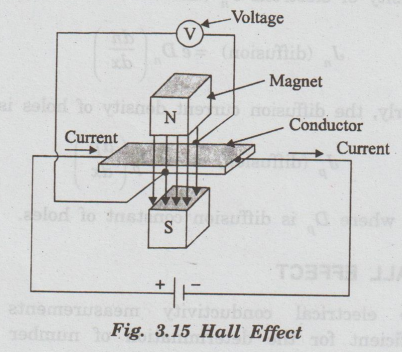
Hall
effect in n- type semiconductor
Consider
a a n-type semiconductor in the form of a rectangular slab. In this slab, the
current flows in X - direction and magnetic field B is applied in Z-direction.
Due to Hall effect, voltage is developed along Y- direction as shown in fig.
3.16.
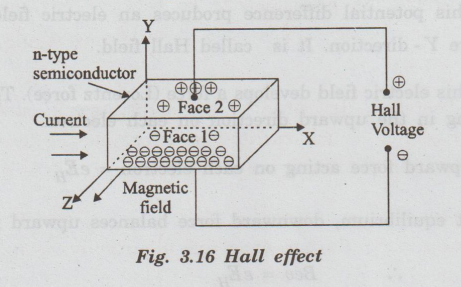
The
current flow is entirely due to the flow of electrons moving from right to left
along X-direction.
fetic
field (B) is
When
a magnetic field (B) is applied in Z-direction, then the electrons moving with
velocity v experience a downward force.
Downward
force experienced by the electrons = Bev …. (1)
This
downward force deflects the electrons in downward direction. Hence, there is an
accumulation of negative charge (electrons) on the bottom face of the slab (fig
3.17).
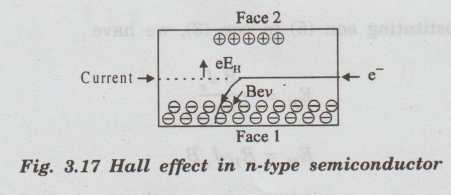
It
causes bottom face to be more negative with respect to top face.
Now,
a potential difference is developed between top and bottom faces of the slab.
This
potential difference produces an electric field E in negative Y- direction. It
is called Hall field.
This
electric field develops a force (Lorentz force). This force is acting in the
upward direction on each electron.
Upward
force acting on each electron = еEH ….(2)
At
equilibrium, downward force balances upward force.
Bev
= eEH
EH
= Bu ...(3)
The
current density (Jx) along X-direction is related to velocity v as
Jx
= - nev ...(4)
where
n is concentration electrons.
v
= -Jx / ne ...(5)
Substituting
eqn (5) in eqn (3), we have
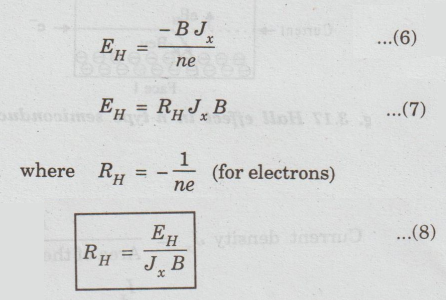
RH
is a constant and it is known as Hall coefficient.
The
negative sign indicates that the electric field is developed in negative Y -
direction.
Hall effect in p-type semiconductor
Similar
to n-type semiconductor, we can write for p-type semiconductor
EH
= RH Jx B
where
Hall coefficient.
RH
= + 1 / pe
where
p is concentration of holes.
The
positive sign indicates that the electrical field (Hallfield) is developed in
positive Y - direction.
Hall coefficient in terms of Hall voltage
If
t is the thickness of the sample and VH is the voltage developed,
then
VH
= EH t
where
E is Hall field. ...(1)
VH
= RH Jx B t ...(2)
If
b is breadth of the sample, then
Cross
sectional area of the sample (A)
=
Breadth (b) × Thickness (t)
=
bt
Current
density Jx = Ix / Area
of the sample (A)
=
Ix / bt …. (3)
Substituting
eqn (3) in eqn (2), we get
VH
= RH Ix Bt /
bt
VH
= RH Ix B /
b
Hall
coefficient RH = VH b / Ix B ...(4)
Note:
For n-type, the polarity (sign) of VH is opposite to
that of p-type.
Determination of Hall coefficient
The
experimental arrangement to measure Hall-coefficient is shown in fig. 3.18.
A
semiconductor is taken in the form of a rectangular slab of thickness t and
breadth b. A suitable current I, ampere is passed into this sample along X-axis
by connecting it to a battery.
Now,
it is placed in between north and south poles of an electromagnet. The magnetic
field is applied along Z-axis.
Due
to Hall effect, Hall voltage (V) is developed in the sample. This voltage is
measured by fixing two probes at the centers of the bottom and top faces of the
sample.
By
measuring Hall voltage, Hall coefficient is determined from the formula
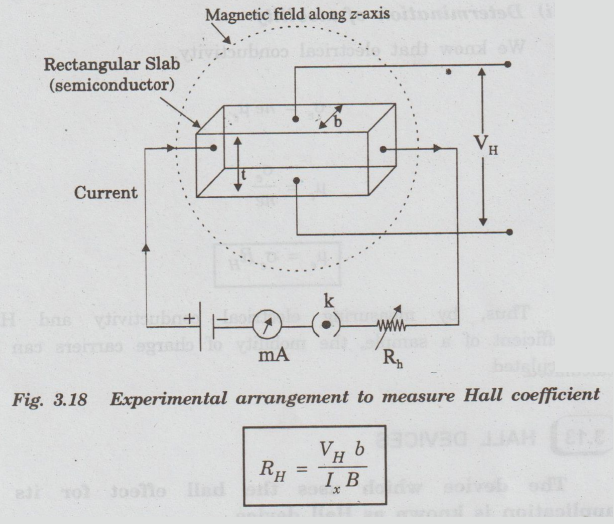
From
Hall coefficient, carrier concentration and mobility can be determined.
Applications of Hall effect
(i) Determination of semiconductor type
The
sign of the Hall, coefficient is used to find whether a given semiconductor is
n-type or p-type.
(ii)
Calculation of carrier concentration
By
measuring Hall coefficient RH, carrier concentration is determined
from the relation
n
= 1 / eRH
(iii)
Determination of mobility
We
know that electrical conductivity,
σe
= ne μe
µe = σe / ne
µe = σe RH
Thus,
by measuring electrical conductivity and Hall coefficient of a sample, the
mobility of charge carriers can be calculated.
Physics for Electrical Engineering: Unit III: Semiconductors and Transport Physics : Tag: : Statement, Applications, Determination of Hall coefficient - Hall effect
Related Topics
Related Subjects
Physics for Electrical Engineering
PH3202 2nd Semester 2021 Regulation | 2nd Semester EEE Dept 2021 Regulation
